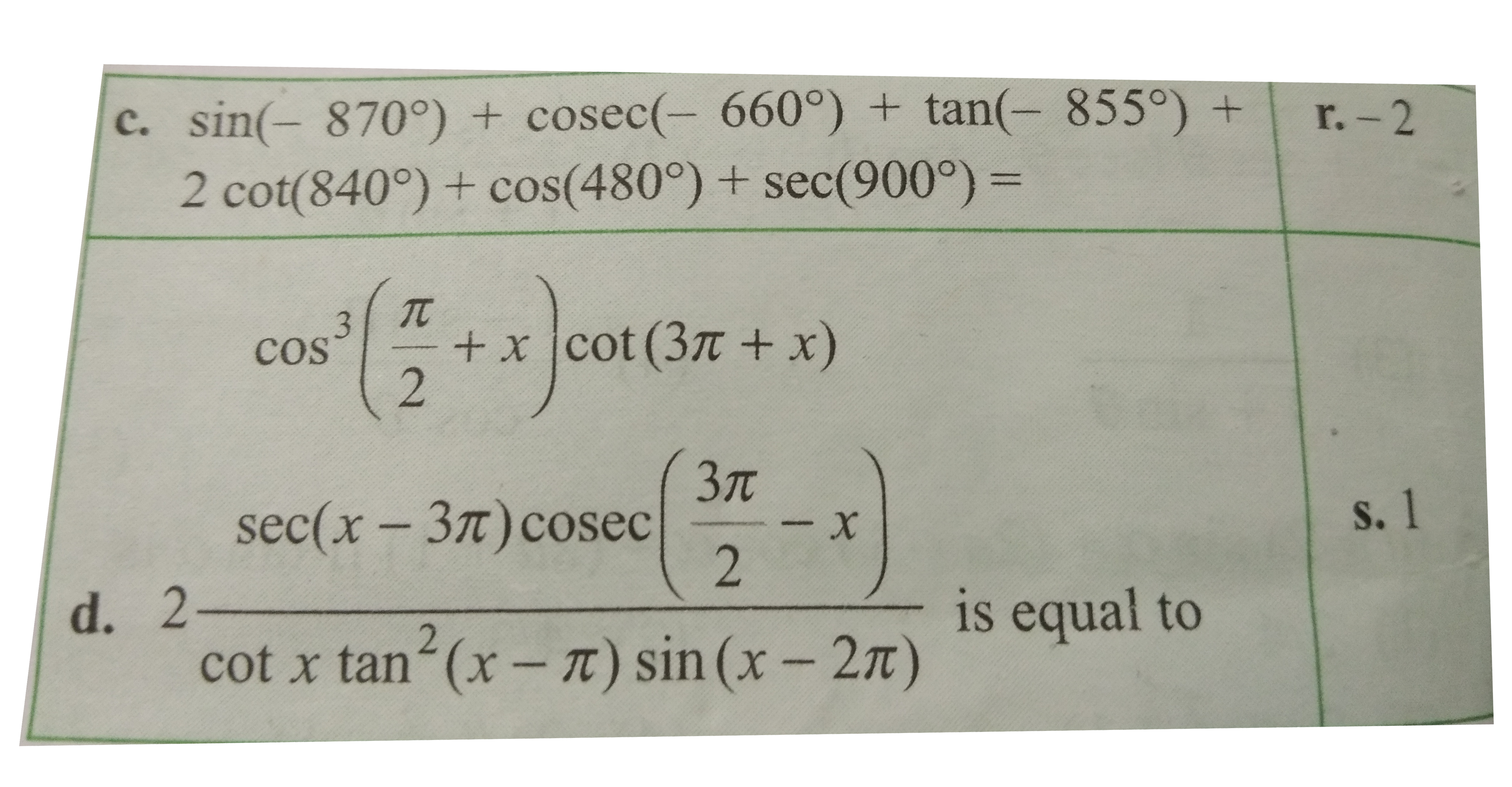If x=secφ−tanφanddy=cosecφ+cotφ, then (a)x=y+1y−1 (b) x=y−1y+1 (c)y=1+x1−x (d) xy+x−y+1=0Solution in Tamil
x=y+1y−1
x=y−1y+1
y=1+x1−x
xy+x−y+1=0
The correct Answer is:B, C, D
We have x=1−sinϕcosϕ,y=1+cosϕsinϕ
Multiplying, we get
xy=(1−sinϕ)(1+cosϕ)cosϕsinϕ
⇒xy+1=1sinϕcosϕ=sinϕcosϕcosϕsinϕ
=1−sinϕ+cosϕcosϕsinϕ
andx−y=(1−sinϕ)sinϕ−cosϕ(1+cosϕ)cosϕsinϕ
=sinϕ−sin2ϕ−cosϕ−cos2ϕcosϕsinϕ
=sinϕ−cosϕ−1cosϕsinϕ=−(xy+1)
Thus, xy+x−y+1=0,x=1+x1−x
Topper's Solved these Questions
- TRIGONOMETRIC FUNCTIONS BOOK - CENGAGECHAPTER - TRIGONOMETRIC FUNCTIONS EXERCISE - Exercise (Comprehension)
11 Videos
- TRIGONOMETRIC FUNCTIONS BOOK - CENGAGECHAPTER - TRIGONOMETRIC FUNCTIONS EXERCISE - Exercise (Matrix)
3 Videos
- TRIGONOMETRIC FUNCTIONS BOOK - CENGAGECHAPTER - TRIGONOMETRIC FUNCTIONS EXERCISE - Exercise (Single)
57 Videos
- TRIGONOMETRIC EQUATIONSBOOK - CENGAGECHAPTER - TRIGONOMETRIC EQUATIONSEXERCISE - Archives (Matrix Match Type)
1 Videos
- TRIGONOMETRIC RATIOS AND TRANSFORMATION FORMULASBOOK - CENGAGECHAPTER - TRIGONOMETRIC RATIOS AND TRANSFORMATION FORMULASEXERCISE - Matrix Match Type
1 Videos
Similar Questions
Let us consider the equation cos4xa+sin4xb=1a+b,x∈[0,π2],a,b>0
The value of sin2x in terms of a and b is
View Solution

View SolutionIf 5tanθ=4, then 5sinθ−3cosθ5sinθ+2cosθ is equal to 0 (b) 1 (c) 16 (d) 6
View SolutionFind the derivative of y=tan−12x3
View SolutionRefer to the following diagram :

Column IColumn IIa.Collinear vectorsp.→ab.Coinitial vectorsq.→bc.Equal vectorsr.→cd.Unlike vectors (same initial point)s.→d
View SolutionFind y(x), if it satisfies the following differential equation dydx=(x−y)2, and given that y(1)=1 (A) −ln∣∣∣1−x+y1+x−y∣∣∣=2(x−1) (B) ln∣2−y2−x=x+y−1 (C) ln∣∣∣1−x+y1+x−y∣∣∣=2(x−1) (D) 12ln∣∣∣1−x+y1+x−y∣∣∣+ln|x|=0
View Solutiony^(2)-(dy)/(dx)=x^(2)
View Solutiondydx=xy(1−x)(1+y) A) x+y+log[y(1−x)]=c B) x+y+log[x(1−y)]=c C) x+y+log(x+y)=c D)y−x+log[x(1−y)]=c
View Solution(x−1)dy−(1+y)dx=0,y=4 if x=2 A)5(x−1)(1+y)=1 B)(x−1)(1+y)=5 C)1+y=5(x−1) D)5(1+y)=x−1
View SolutionIf x=secφ−tanφandy=cosecφ+cotφ, then x=y+1y−1 (b) x=y−1y+1 y=1+x1−x (d) xy+x−y+1=0
View SolutionWhen simplified (x−1+y−1)−1 is equal to
(a) xy
(b) x+y
(c) xyx+y
(d) x+yxy
View SolutionThe factors of x3−1+y3+3xy are
(a) (x−1+y)(x2+1+y2+x+y−xy)
(b)(x+y+1)(x2+y2+1−xy−x−y)
(c)(x−1+y)(x2−1−y2+x+y+xy)
(d)3(x+y−1)(x2+y2−1)
View SolutionThe solution of the differential equation dydx+1=ex+y, is a. (x+y)ex+y=0 b. (x+C)ex+y=0 c. (x−C)ex+y=1 d. (x+C)ex+y+1=0
View SolutionThe solution of the differential equation (x2+1)dydx+(y2+1)=0 is
a. y=2+x2
b. y=1+x1−x
c. y=x(x−1)
d. y=1−x1+x
View SolutionFind y(x), if it satisfies the following differential equation dydx=(x−y)2, and given that y(1)=1 (A) −ln∣∣∣1−x+y1+x−y∣∣∣=2(x−1) (B) ln∣2−y2−x=x+y−1 (C) ln∣∣∣1−x+y1+x−y∣∣∣=2(x−1) (D) 12ln∣∣∣1−x+y1+x−y∣∣∣+ln|x|=0
View SolutionFind the equations of the diagonals of the square formed by the lines x=0,y=0,x=1,y=1. a)y=x,y+x=1 b)y=x,x+y=2 c)2y=x, y+x=13 d)y=2x,y+2x=1
View Solution
